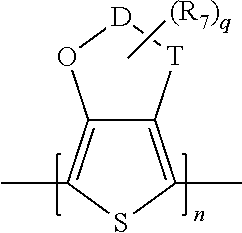Temperature Stable Solid Electrolytic Capacitor
a solid electrolytic capacitor, temperature stable technology, applied in the manufacture of electrolytic capacitors, capacitor details, capacitors, etc., can solve the problem of high temperature dependence of capacitors
- Summary
- Abstract
- Description
- Claims
- Application Information
AI Technical Summary
Benefits of technology
Problems solved by technology
Method used
Image
Examples
example 1
[0074]70,000 μFV / g tantalum powder was used to form anode samples. Each anode sample was embedded with a tantalum wire, sintered at 1280° C., and pressed to a density of 6.8 g / cm3. The resulting pellets had a size of 1.80×1.20×2.40 mm. The pellets were anodized to 14.4V in water / phosphoric acid electrolyte with conductivity 8.6 mS at temperature of 85° C. to form the dielectric layer. A conductive polymer coating was then formed by dipping the anodes into a butanol solution of iron (III) toluenesulfonate (Clevios™ C, H. C. Starck) for 5 minutes and consequently into 3,4-ethylenedioxythiophene (Clevios™ M, H. C. Starck) for 1 minute. After 45 minutes of polymerization, a thin layer of poly(3,4-ethylenedioxythiophene) was formed on the surface of the dielectric. The parts were washed in methanol to remove reaction by-products, anodized in a liquid electrolyte, and washed again in methanol. The polymerization cycle was repeated 12 times. The parts were then dipped into a graphite dispe...
example 2
[0075]Capacitors were formed in the manner described in Example 1, except that using a different conductive polymer coating. A conductive polymer coating was then formed by dipping the anodes into a butanol solution of iron (III) toluenesulfonate (Clevios™ C, H. C. Starck) for 5 minutes and consequently into 3,4-ethylenedioxythiophene (Clevios™ M, H. C. Starck) for 1 minute. After 45 minutes of polymerization, a thin layer of poly(3,4-ethylenedioxythiophene) was formed on the surface of the dielectric. The parts were washed in methanol to remove reaction by-products, anodized in a liquid electrolyte, and washed again in methanol. This process was repeated 6 times. Thereafter, the parts were dipped into a dispersed poly(3,4-ethylenedioxythiophene) having a solids content 2% and viscosity 20 mPa·s (Clevios™ K, H. C. Starck). Upon coating, the parts were dried at 125° C. for 20 minutes. This process was not repeated. Thereafter, the parts were dipped into a dispersed poly(3,4-ethylened...
example 3
[0076]Capacitors were formed in the manner described in Example 1, except that using a different conductive polymer coating. A conductive polymer coating was then formed by dipping the anodes into a butanol solution of iron (III) toluenesulfonate (Clevios™ C, H. C. Starck) for 5 minutes and consequently into 3,4-ethylenedioxythiophene (Clevios™ M, H. C. Starck) for 1 minute. After 45 minutes of polymerization, a thin layer of poly(3,4-ethylenedioxythiophene) was formed on the surface of the dielectric. The parts were washed in methanol to remove reaction by-products, anodized in a liquid electrolyte, and washed again in methanol. This process was repeated 6 times. Thereafter, the parts were dipped into a dispersed poly(3,4-ethylenedioxythiophene) having a solids content 2% and viscosity 20 mPa·s (Clevios™ K, H. C. Starck) and additional 20% solids content of poly(ethylene glycol) with molecular weight 600 (Sigma AldrichR). Upon coating, the parts were dried at 125° C. for 20 minutes...
PUM
| Property | Measurement | Unit |
|---|---|---|
| temperature | aaaaa | aaaaa |
| temperatures | aaaaa | aaaaa |
| temperatures | aaaaa | aaaaa |
Abstract
Description
Claims
Application Information
 Login to View More
Login to View More - R&D
- Intellectual Property
- Life Sciences
- Materials
- Tech Scout
- Unparalleled Data Quality
- Higher Quality Content
- 60% Fewer Hallucinations
Browse by: Latest US Patents, China's latest patents, Technical Efficacy Thesaurus, Application Domain, Technology Topic, Popular Technical Reports.
© 2025 PatSnap. All rights reserved.Legal|Privacy policy|Modern Slavery Act Transparency Statement|Sitemap|About US| Contact US: help@patsnap.com



